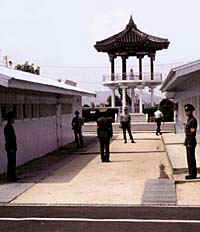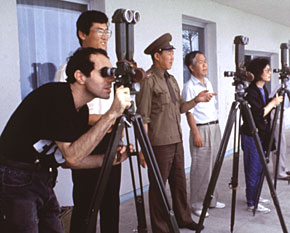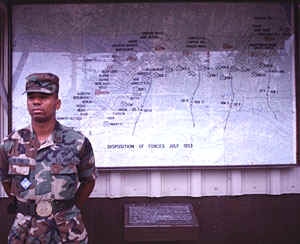On the Border
For half a century, the DMZ has divided the two Koreas, keeping the Land of Morning Calm in a freakish state as the last fault line in the Cold War. But a thaw is underway and the world's most fortified battle zone is being transformed - into a tourist trap
By Ron Gluckman / Panmunjom, North Korea
T
HE MINI-BUS BOUNCES ALONG RUTTED ROADS, over one last hill of wildflowers, then skirts a strand of barbed wire and skids to a stop alongside a concrete bunker. Passengers pile out as we arrive in the holiday hellhole.All that is missing is a big banner proclaiming: "Welcome to the
weirdest tourist trap on Earth."
Certainly the Korean Demilitarized Zone qualifies on all counts. There are no hotels, cabbies or prostitutes plying the world's oldest trade. Lest it sound too perfect, there IS a duty free gift shop dispensing wacky souvenirs from the most militarized zone on the planet.
With the wall down in East Europe and relations thawing between western and communist powers everywhere from Vietnam to the former Soviet Union, the border between the two Koreas represents the final face off leftover from the Cold War.
North Korea, desperate for cash, has turned the conflict zone into a tourist attraction without compare. Japanese visitors focus upon a desolate expanse of barbed wire, hungry for exotic snapshots of land mines, armed guards and bulletin boards bursting with hate literature. They peer into the distance, where two million Koreans died in the bloody civil war and millions more remain armed and ready for a repeat engagement.
Tourist brochures to the contrary; there is little tranquility left in the kingdom once called the Land of Morning Calm.
The truce village of Panmunjom, which was leveled in the Korean War, sits at the end of the Reunification Highway. The name is satire of the most tragic sort. The four paved lanes are wide and empty, the route short and sorrowful. A signpost notes that Seoul is only 70 kilometers further, however such sentiments are wishing-well dreams. The highway ends in bales of barbed wire and piles of paranoia at Panmunjom. Everyone is well aware that to even try to cross over means certain death.
The border tour involves a walk through the main gate to a complex of buildings where the reunification talks have been held to little purpose in the four decades since war split this once-serene land. Tourists can pose for pictures at the actual table where the negotiations take place, a huge line running through the building and the table itself.
Helmeted members of the multinational force watch the proceedings from the South Korean side with more than mere curiosity. They peer in the windows and shoot photos of visitors with telephoto lenses. Some visitors turn away, but the less timid tourists snap right back.
 From a tall observation tower, visitors to the North Korean side of the
DMZ watch guests on the other side of the line climb the steps of a similar tower. A
slight wind brings the smell of pines from the green hills in the distance. A flock of
white egrets settle in the nearby marshlands. Except for the chirping of birds, it's all
quiet on the world's most perilous front.
From a tall observation tower, visitors to the North Korean side of the
DMZ watch guests on the other side of the line climb the steps of a similar tower. A
slight wind brings the smell of pines from the green hills in the distance. A flock of
white egrets settle in the nearby marshlands. Except for the chirping of birds, it's all
quiet on the world's most perilous front.
After a military briefing filled with anti-American accusations, visitors are shuttled to a gift shop for the inevitable souvenirs. There are pins and posters, and books in six languages detailing the atrocities committed by "the American hooligans" and their "south Korean stooges." Most remarkable, though, payment must be made in US dollars.
On the walls hang old photographs detailing further alleged American and South Korean atrocities. The photographs are familiar to foreign visitors; they are displayed inside every train station, airport and most government buildings. A photo of an angry crowd is captioned, "South Korea Under the Occupation of the US Imperialists." Others mention "the south Korean puppet police" and praise "the patriotic students of south Korea."
And it gets more ridiculous. One little booklet reproduces numerous "secret US war plans." The only readable document is a letter from former American Secretary of State John Dulles thanking his Seoul hosts for dinner and the gift of a vase.
Not to be outdone, South Korea brings busloads of tourists to the border for a feast of propaganda that shows nothing so much as how close these kindred people remain, at least in terms of paranoid schizophrenia.
Beaches as distant as Cheju Island are surfaced to reveal footprints and patrolled nightly to prevent against a North Korean invasion. Students are drilled on subversion and sedition. Bus signs warn South Koreans to look out for spies.
Reminders are constant that, despite four decades of co-existence, nothing more than a temporary truce was declared between the Koreas. One of the more grisly episodes in the tenuous truce occurred in the summer of 1976 when an American work detail attempted to trim a tree. They encountered a sizable North Korean force. In the ensuing skirmish, two US army officers were hacked to death and at least nine soldiers wounded.
Such confrontations may explain the size of the UN forces at the DMZ. The soldiers are mountainous specimens. Americans must be at least six-feet tall and 200 pounds, according to our guide, Sgt. Gregory Hilton of Baltimore. Koreans must be above average height and weight and hold a black belt in at least one marshal art. Smiling, apparently, is not required.
 All in all, it was like wrestling night at the forum. Only not nearly
as much fun. For all the boasting about the superiority of the American Way, sad to say,
the North Koreans throw a better border party.
All in all, it was like wrestling night at the forum. Only not nearly
as much fun. For all the boasting about the superiority of the American Way, sad to say,
the North Koreans throw a better border party.
We saw some silly film of goose-stepping North Korean guards. There was other finger pointing at alleged shortages of goods and brutality on the north side. Rather than take the high road, the UN forces mounted a parallel propaganda campaign.
The South Korean viewing platform is called Freedom House. It overlooks Freedom Bridge. Hilton described how each side has a small village within the border zone. On the North Korean side is Kijong-dong, which means Peace Village. "We call it Propaganda Village," says Hilton, insisting that the town is inhabited only by guards who blare North Korean propaganda from loudspeakers.
Across the line, less than two kilometers to the south is Daesong-dong, perhaps the most heavily-guarded settlement on Earth. Some 40 families farm the area under armed guard and strict regulations. They must be in by 10 p.m. Lights out is 11. Nonetheless, Hilton says without a touch of irony, the town is nicknamed "Freedom Village."
Both villages boast flagpoles that grew in scale over the years. In this instance, UN forces finally surrendered. The North Korean flag in Kijong-dong stands 160 meters high. The flag is 30 meters long and is estimated to weigh 600 pounds. Both flag and pole are the largest in the world, Hilton notes with disdain.
Such schoolyard antics spill into the peace hearings. Panmunjom, which was razed during the Korean War, was rebuilt largely to maintain contact between the Korean factions. From July 1951, until the armistice was signed two years later, over 1,000 meetings were held in the town --- the longest truce talks ever. The talks continue, but snag on nearly everything.
Take, for instance, the issue of the table flags. Each side tried to upstage the other by bringing to the talks larger and larger delegation flags, eventually dwarfing the delegations. A set of standards resolved this conflict. Or did it?
"Theirs is slightly taller," says Hilton, "but ours has a bigger width tip on top. The North Korean base is three tiers, but ours has two big ones, so it's the same size. Their flag is longer, but ours is wider."
So it goes at the Korean DMZ, where business in grim border tours remains brisk and the chill of the Cold War seems a long, long way from thawing.
Ron Gluckman is an American reporter based in Hong Kong, who roams around the nether reaches of Asia for a variety of publications, including Time, Newsweek, the Wall Street Journal, Discovery, the Sydney Morning Herald and the South China Morning Post, which ran this story in its weekend magazine in 1992. For other stories on North Korea, click on Cinema Stupido, Great Escape, or Last Tango in the People's Paradise
To return to the opening page and index
push here
[right.htm]
